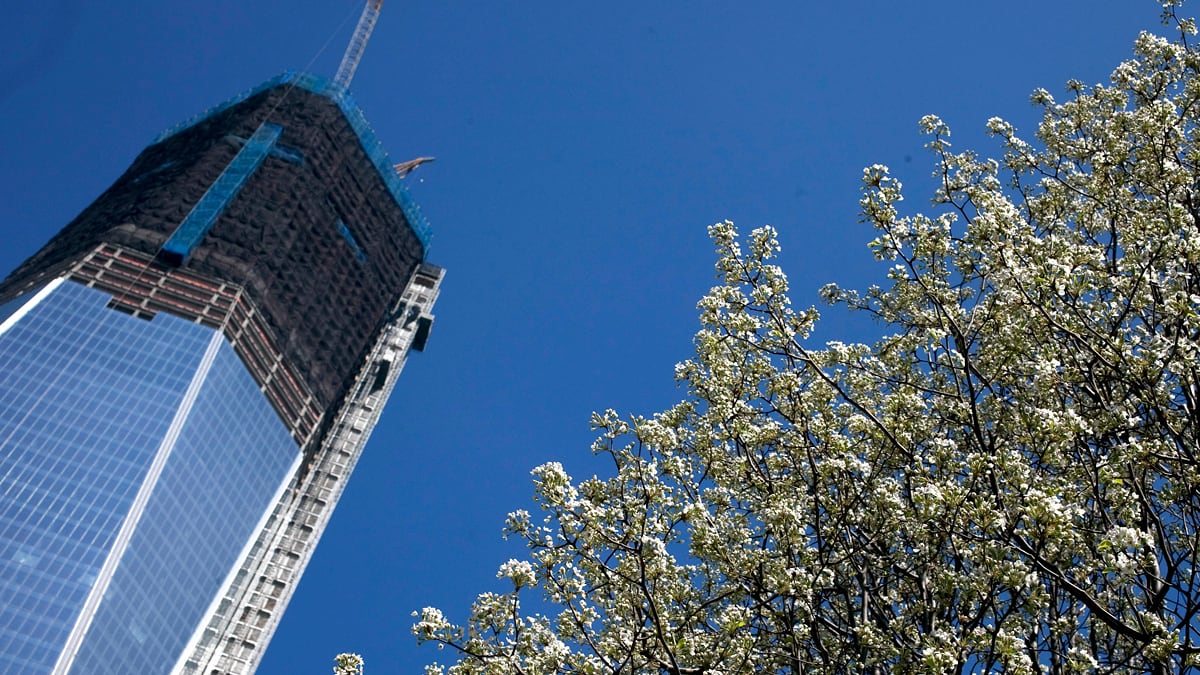Nothing manmade at the Sept. 11 Memorial this week was remotely as stirring as the blooming of what has become known as the Survivor Tree.

The tree is always a compelling sight for being the last living thing pulled from the smoking ruins and for having grown back from a charred and splintered stump to a full 30 feet.
But as a Callery pear, it is also one of the earliest trees to bloom and it has now done so for the first time since the memorial opened. The 225 other trees there are swamp white oaks that still stand stark as winter. The contrast makes the Survivor Tree’s flowering all the more startling; life renewed and continued in an already surprisingly early spring at a place of still unimaginable loss.
The delicate white blooms drew crowds of visitors around the tree on Thursday. They seemed to momentarily forget the rest of the memorial, many taking pictures and posing in turns. A woman turned to Port Authority Police Lt. John Ryan.
“Can you take a picture of us please?” she asked.
The woman handed Ryan her iPhone and stood with her family in front of the tree, smiling without seeming at all inappropriate in this place of still unimaginable loss. She then took the iPhone back and inspected the result.
“That’s beautiful,” she said.
A half dozen other people made the same request, and Ryan obliged them all. He recalled another recent visitor, a young marine who had arrived on two prosthetic legs to replace the ones he had lost along with an arm and part of his remaining hand to an IED in Afghanistan in October.
“He said, ‘Don’t worry if I fall, I’m good at falling,’” Ryan reported.
The marine was accompanied by a visibly pregnant wife and he had managed a kind of bloom of his own that marked him kin to the Survivor Tree.
“A grin from ear to ear,” Ryan said. “He looked very happy to be alive.”
The marine also appeared to be experiencing the buoying effect that the memorial seems to have on many wounded warriors who visit there. They are reminded that this is where it started and that it started with the murder of thousands of innocents and that this is not changed by all the subsequent blunders of those in charge. Those who answered the call can stand here and feel that the cause was indisputably just at its inception.
“It gives them a certain degree of peace,” Ryan said. “Not that I could ever make up for their sacrifices.”
Even this degree of peace was denied marines in our last protracted war. My friend Pat Brown was a marine in Vietnam and never forgot the pain of being called a murderer and a baby killer when he returned home. He found his measure of peace in becoming a rescuer and a baby saver with the FDNY. He was a captain and one of the most decorated members in the department’s history when he led Ladder 3 up into the burning North Tower on 9/11. He contacted the dispatcher to say he was on the 35th floor and sending down numerous burned civilians. The tower was minutes from collapsing when he uttered the final words of somebody who was a rescuer to the very end.
“Three Truck and we’re still headed up.”
In eulogizing Brown in Saint Patrick Cathedral, Firefighter Mike Moran declared that the hijackers had not been rewarded with virgins in Paradise. They had instead arrived there to encounter Capt. Patrick J. Brown.
“And they discovered they messed with the wrong Marine,” Moran said.
The whole country was behind the marines and soldiers who went into Afghanistan just as the whole country was behind those who went to war after Pearl Harbor. The Bush administration then used 9/11 as a pretext to go into Iraq, at the same time diverting our focus from the hunt in Afghanistan for Osama bin Laden and the others behind the worst mass murder on U.S. soil.
When we finally did get bin Laden, a big crowd gathered down at Ground Zero, chanting “USA! USA!” while the son of a firefighter who died on 9/11 played bagpipes. The war in Iraq had by then turned into a disaster. Afghanistan was headed toward defeat in everything but name, with the fighting turning ever more vicious, resulting in the highest number of lost limbs of any period in these past nine years of war.
On March 12, a day after he is said to have seen a fellow soldier lose a leg to a mine in Afghanistan, Army Sgt. Robert Bales allegedly went on a shooting rampage, killing 17 innocent civilians, nine of them children. He had enlisted after 9/11 and served three tours in Iraq fighting people who had nothing to do with 9/11. He is said to have “lost faith in the mission” before being sent to Afghanistan in December.
A war that had begun with the murder of Brown and so many other innocents had now led to an American in uniform becoming an actual baby killer, beyond all excuse or rationale. I remembered the hurt in Brown’s voice when he told me of his homecoming after Vietnam and for reasons I cannot fully explain I had a growing urge to visit Ground Zero. I would have done so even if I had not heard that the impossibly fine weather had caused the Survivor Tree to bloom.
The construction of the new tower has passed the 90th floor and as I drew near I tried not to hate it. The glinting heights only make me think the people I watched jump from the burning towers that equally sunny morning more than a decade ago. I reminded myself that one of Brown’s favorite fellow firefighters, Mickey Conboy, has a son who is now one of the ironworkers on the project.
“They knocked it down and I’m putting it back up,” the son told Conboy the other day.
I passed through security with a line of visitors from at least six different countries and I hoped that their presence here meant they still saw us as the America of Patrick Brown, not of Robert Bales. We entered the memorial grounds there and it was, in a grove of barren oaks, the Survivor Tree in resplendent bloom,
The tree is ringed by a protective steel railing and steadied by guy wires, but there is no sign to identify it. Many of the visitors nonetheless seemed to know its story and appeared happy to tell it to anyone who asked. More than a few who took a photo or two then stepped forward to take close-ups of the flowers; impeccable new creations, each comprised of five delicate white petals.
Ryan stood nearby and spoke of the Marine who said he had become good at falling after he lost two legs and an arm. The Survivor Tree suddenly looked more perfect for missing limbs that kept it from completely recovering its original shape and left its blooming asymmetrical.
“It is important,” a visitor said to Ryan of the tree.
I stepped over to the memorial pool marking the footprint where the South Tower once stood. On the edge facing the Survivor Tree, surrounded by the names of other fallen first responders, were the names of Brown the others from Ladder 3 who died with him. The captain’s brother, Mike Brown, said at the memorial’s official opening on the 10th anniversary of 9/11 that he was less moved by seeing the name “Patrick J. Brown” than he was by the names of the civilians Patrick J. Brown and his comrades died trying to save. Mike Brown had noted that the names of the women who were pregnant have an addendum, “and her unborn child.”
The truck that Ladder 3 rode to the World Trade Center was recovered and will serve as a centerpiece at the museum, a battered and partly crushed artifact of bravery in the face of monstrous death. The thousands of names inscribed around the pools whose edges remain black in even the brightest sunshine might make you believe that death won. And for a brief, bleak moment on Thursday I felt it had.
Then, I turned back to the blossoming tree that stands as a scarred and resolute exhibit of the life force itself. A large school group gathered around it, the students in their early teens, not much more than children, but also not so far from military age. Their teacher asked Ryan about the tree and then relayed the class a story of survival that they would take with them.
“Which is a good thing,” Ryan said.
At another point in the day, a woman stepped up to the tree holding a boy of about five. He reached up with his hand and she hoisted him higher until he was within reach of the blooms. He appeared certain to pluck one, but the power of this tree and of this place was such that he knew better. He only brushed a flower so lightly with his fingertips that he did not disturb as much as a petal.
And to think that a soldier from the war that began at this very place was facing charges of being a baby killer such as Patrick Brown never could have been.






